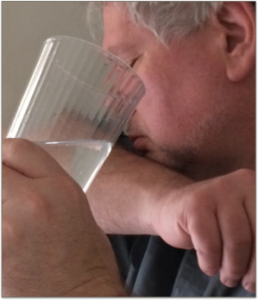Chapter 2: Disorders of Swallowing
 Dysphagia refers to difficulty swallowing with its cause somewhere between the mouth and the stomach. Dysphagia is not a disease, but rather a symptom of a disease. It may result from an anatomic or physiologic alteration that negatively affects the bolus flow. However, it is possible to have altered anatomy and physiology, yet still have a safe and efficient swallow. Dysphagia differs from a feeding disorder, which may be related to either poor food placement in the mouth, or in the case of an infant, the inability to suck or coordinate the suck-swallow-breathe pattern needed for a successful feeding. This chapter will describe commonly reported signs and symptoms that occur with dysphagia, and explore different ways that the swallow can be impaired.
Dysphagia refers to difficulty swallowing with its cause somewhere between the mouth and the stomach. Dysphagia is not a disease, but rather a symptom of a disease. It may result from an anatomic or physiologic alteration that negatively affects the bolus flow. However, it is possible to have altered anatomy and physiology, yet still have a safe and efficient swallow. Dysphagia differs from a feeding disorder, which may be related to either poor food placement in the mouth, or in the case of an infant, the inability to suck or coordinate the suck-swallow-breathe pattern needed for a successful feeding. This chapter will describe commonly reported signs and symptoms that occur with dysphagia, and explore different ways that the swallow can be impaired.
Learning Objectives
Upon completion learners will be able to:
- Define the difference between feeding disorders and swallowing disorders
- Describe common signs and symptoms of dysphagia to serve as clinical red flags
- Link signs and symptoms of dysphagia to anatomic and/or physiologic deficits
- Define the difference between penetration and aspiration, and the role of the timing of the event to pinpoint the etiology
Reading Guide
- Define the terms signs, symptoms, sensitivity, and specificity.
- Generate a list of common symptoms associated with dysphagia. Describe the possible swallow deficit(s) associated with each symptom.
- Discuss how combinations of signs can be used to predict the likelihood of dysphagia.
- Discuss the importance of cough as a protective mechanism. Describe the differences between a spontaneous and voluntary cough.
- Describe failure to thrive. How is it the same and different in kids versus adults?
- List and describe alternate means of nutrition.
- Discuss the impact of oral care on overall health.
- Describe the difference between absent swallow trigger, delayed swallow trigger, premature spillage, and piecemeal deglutition. Indicate if any of these are considered within normal limits for swallowing.
- In detail, describe what evidence can be gained from residue. Be specific about the location of the residue.
- What is the impact of inadequate velar function on various aspects of swallowing?
- Describe age-related changes and indicate how they can lead to deficits in swallowing.
- List the key aspects of swallow that would be disturbed with damage to specific cranial nerves.
- Define aspiration and penetration. Indicate how timing of aspiration implicates dysfunction.
- Describe common signs and symptoms in the following patient groups: (a) status/post stroke, (b) head and neck cancer, (c) tracheotomy tube.
Chapter 2 Covers:
- Signs & Symptoms of Oropharyngeal Dysphagia
- Impact of Anatomical & Physiological Alterations on Swallow Function
- Impact of Cranial Nerve Damage on Swallow Function
- Impact of Medical Diagnosis on Swallow Function
- Outcomes Associated with Oropharyngeal Dysphagia

